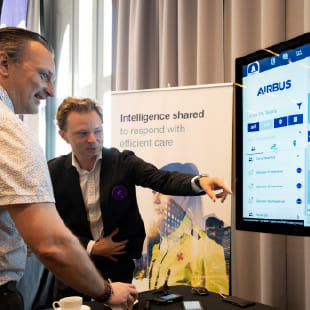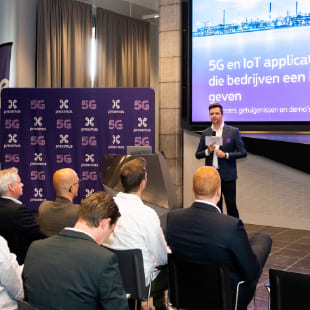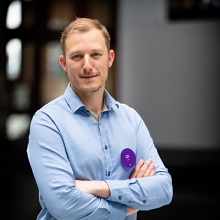Cases show the power of 5G
Published on 22/06/2023 in Events
5G is a game changer for the industry. Cases relying on the new generation of mobile connectivity are gradually reaching cruising speed. From port and construction sector to factory or warehouse, 5G will soon be making a difference almost everywhere.

Late May, there was plenty of interest for the Proximus event on 5G and IoT applications “that boost businesses”. No coincidence that the presentations took place in the Antwerp Havenhuis [Port House]. After all, the port of Antwerp-Bruges is fully committed to digitalization. 5G is never far away. “Our aim is to build a smart port,” says Erwin Verstraelen, CDIO at the Port of Antwerp-Bruges, “with integrated operations that can easily switch between different modes of transport. Secure data exchange lies at the heart of this.”
The port collects this data though various sensors spread over the port area of more than 120 square kilometers. The sensors allow us to remotely see, hear, smell, and feel what is going on in the port. Erwin Verstraelen: “We have sensors to monitor air and water quality. We measure how much pressure a ship exerts on the mooring posts, and so on. This way, we’re building a digital twin of the entire port, step by step.”
Proof of value
One of the most conspicuous applications in the port is the use of automated drones, with 5G as the underlying connectivity. With the D-Hive drone network, drone flights can be booked in the port as a service. Behind the network is the 6th NeTWorK consortium, founded in late 2020 by DroneMatrix, a developer of drones and drone software; SkeyDrone, service provider for drone aviation; and Proximus.
The port now has six base stations for drones. The network ensures that we have extra eyes all over the port.
Erwin Verstraelen, CDIO Port of Antwerp-Bruges
The port authority uses drone services for inspection flights, detecting pollution on the water, providing assistance to fire and police departments, and more. Erwin Verstraelen: “The port now has six base stations for drones. The network ensures that we have extra eyes all over the port.” The case matches well with the port’s innovation strategy. Erwin Verstraelen concludes: “We believe in proof of value. A proof of concept only proves that something works. The proof of value shows what an application truly delivers.”
From voice to data
The rollout of 5G is also changing a lot for Airbus, the European company that provides the TETRA network in Belgium along with Proximus. “The way communications is progressing changes rapidly,” says Yves Van Tente, Business Development Manager at Airbus. “There’s a shift from voice – using narrowband, like TETRA – to data communication, which needs broadband, like 4G or 5G.” Among other things, Airbus is responding to this with new applications, which, for example, enable the classic push-to-talk – typical of mobile communications over TETRA – on the smartphone via 4G or 5G.
Augmented reality gaining momentum
The greater capacity and low latency of 5G also enable applications that were previously unworkable. “The availability of 5G is accelerating the use of augmented reality (AR), among other things,” says Wouter Martens, CTO at Mr. Watts. For the construction company Hooyberghs, Mr. Watts developed an AR application that overlays the plans of a building at full size, as it were, over the real site.
As just one example, using AR glasses, a construction company employee can then immediately see where certain pipes will be installed. “Thanks to 5G, we can link the glasses instantaneously to the cloud, where the necessary computing power is located.”
Time-critical
Meanwhile, industry is also eagerly awaiting the rollout of 5G. Until now, time-critical communication, for example between machines on the production floor, was by necessity done with wired solutions. “4G is good for voice and video but not for time-critical communication,” says Peter-Jan Deltour, Industrial Network & Security Specialist at Phoenix Contact, a manufacturer of automation components. “5G is changing that. Thanks to 5G, response times of less than 10 milliseconds are within reach. An extra advantage is that 5G is the first technology that allows a private mobile network to really stay local.”
5G allows you to collect and analyze more data and better data. So you can gain new insights.
Francis Defauw, CMO at Codit





New insights
While 5G will soon take industrial automation to the next level, the technology also offers many opportunities to do more with IoT applications. 5G allows for more data and better data collection and analysis. “This allows you to gain new insights,” says Francis Defauw, CMO at Codit, the Proximus subsidiary whose specializations include the development of IoT applications. “Data analysis also leads to greater operational efficiency, new business models and new revenue streams.”
For instance, IoT allows the remote monitoring of offshore wind turbines and the optimizing of the efficiency of a tanker. Francis Defauw: “For Euronav, we measure 400 different values on a ship. Based on the analysis of that data, our application gives suggestions to the captain, such as the fastest or cheapest route.” This application allows Euronav to adjust the diesel consumption of its fleet, and thus also reduce ship emissions.
Getting started with 5G
Companies wanting to test a case that relies on 5G themselves can do so at several locations. Proximus is a 5G partner in the innovation hubs A6K (engineering, Charleroi), Howest (gaming, Bruges), and Fabriek Logistiek (logistics, Ghent). Companies can of course also test 5G cases on their own site, both on the public 5G network and via a temporary 5G-PN (Private Network).
A 5G Private Network is a closed network specially built to meet the needs of a specific organization. It offers higher bandwidth, lower latency, and more security than public networks, resulting in better performance, reliability, and efficiency. This makes it ideal for companies looking to implement advanced applications such as augmented reality, industrial automation, and autonomous vehicles.
One
One magazine is the Proximus B2B magazine for CIOs and IT professionals in large and medium-sized organisations.

